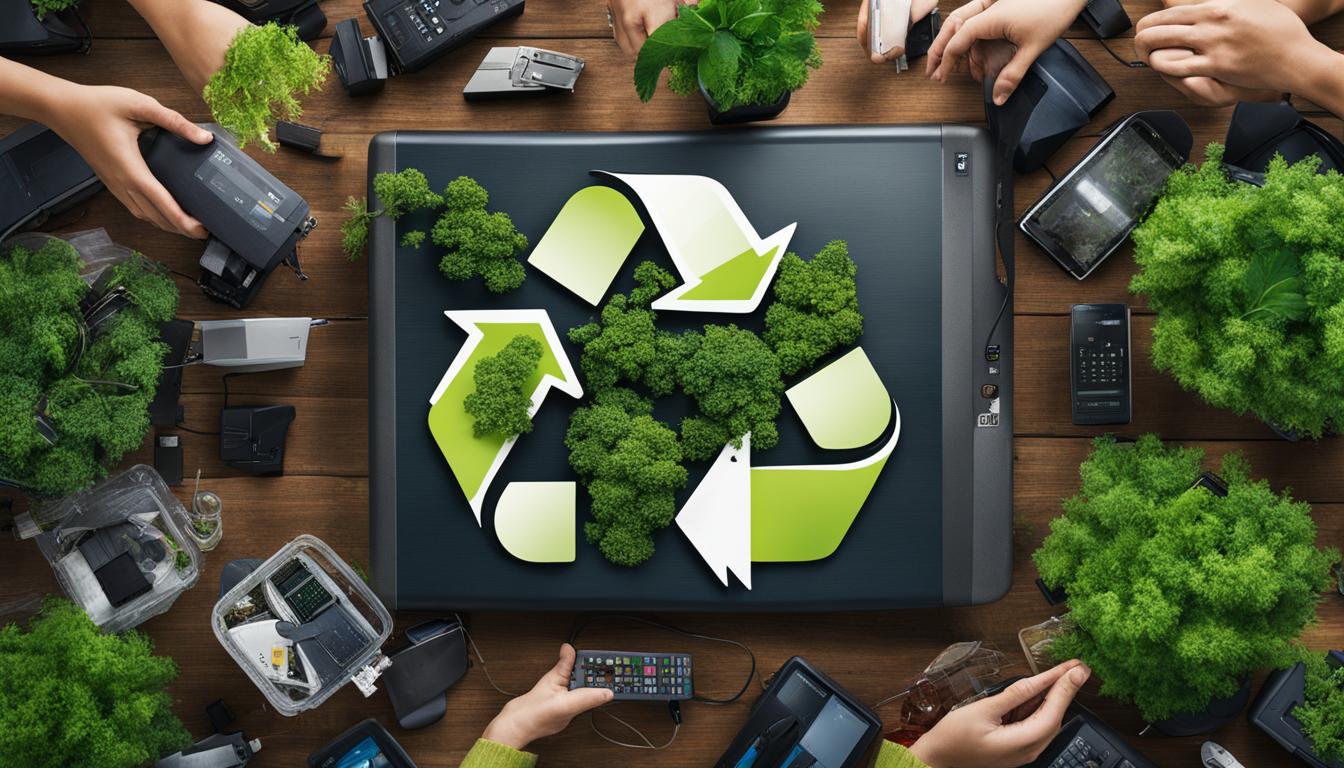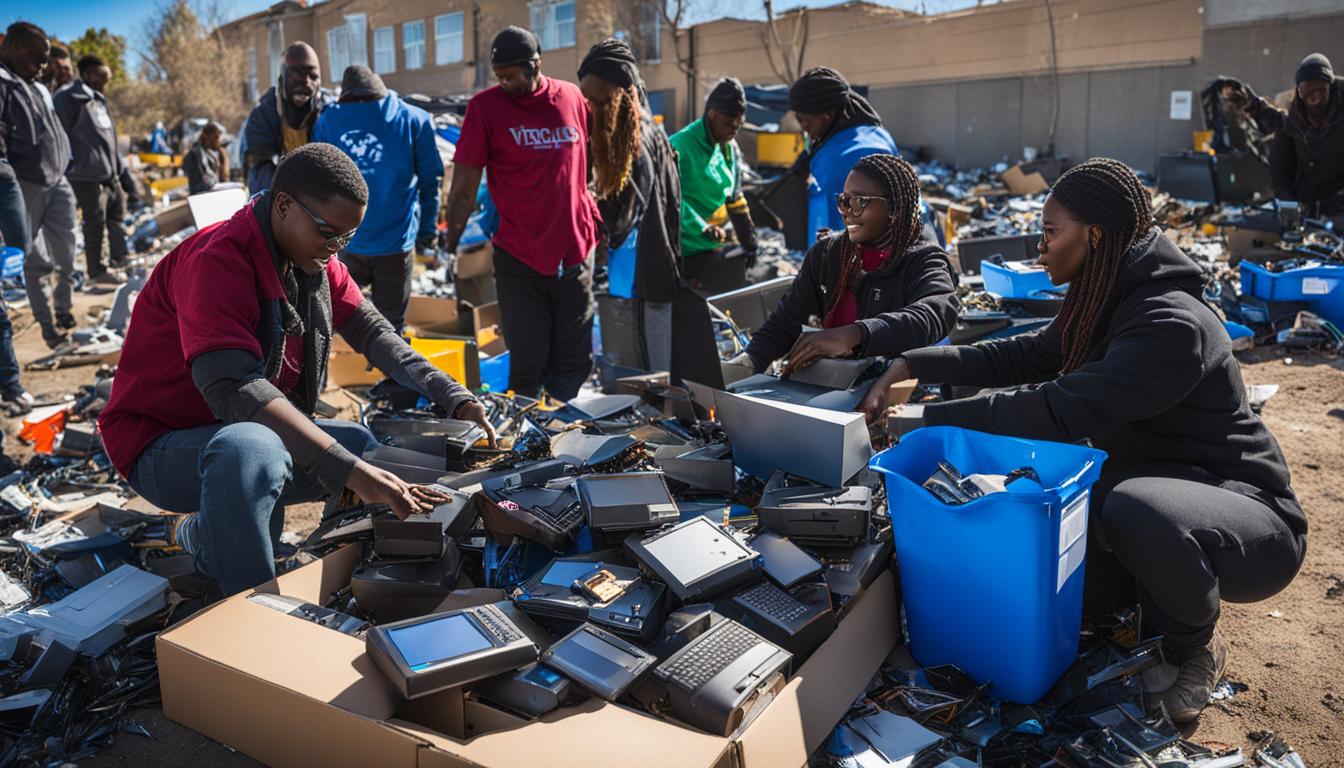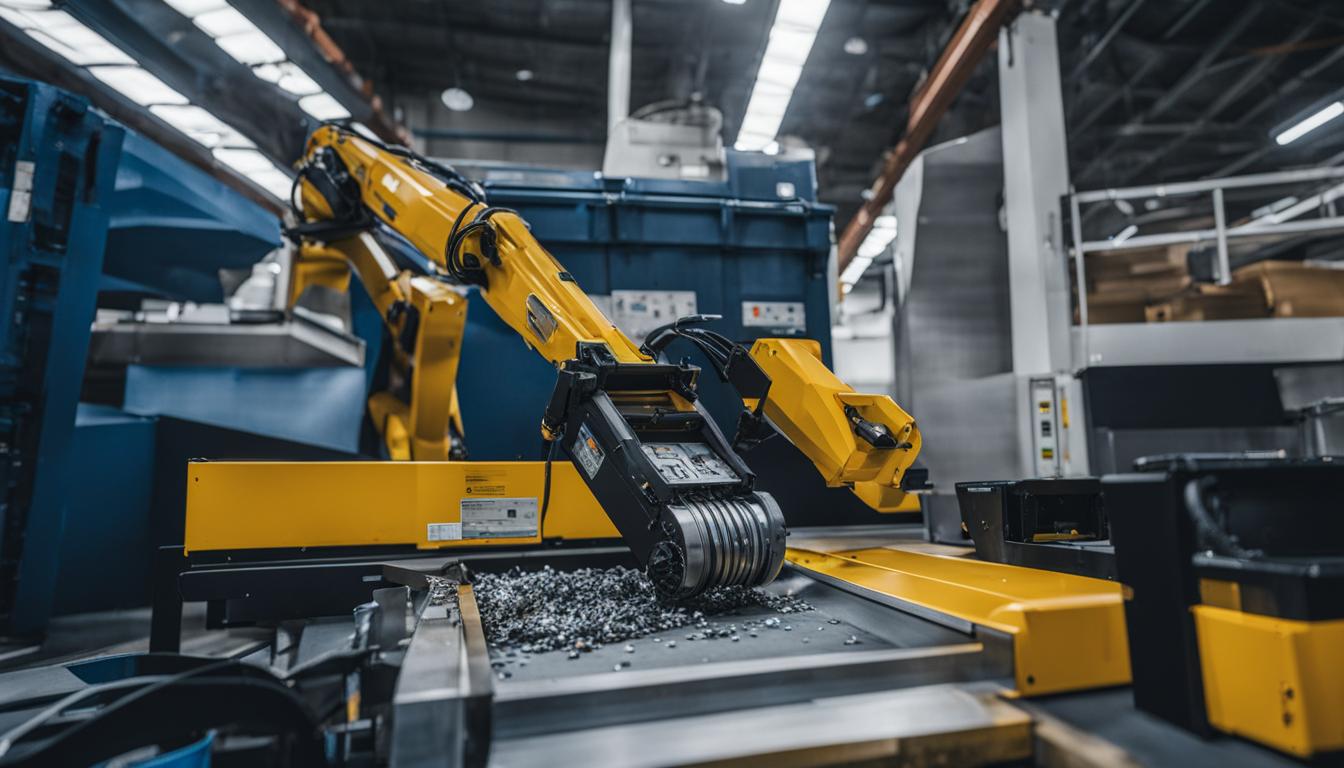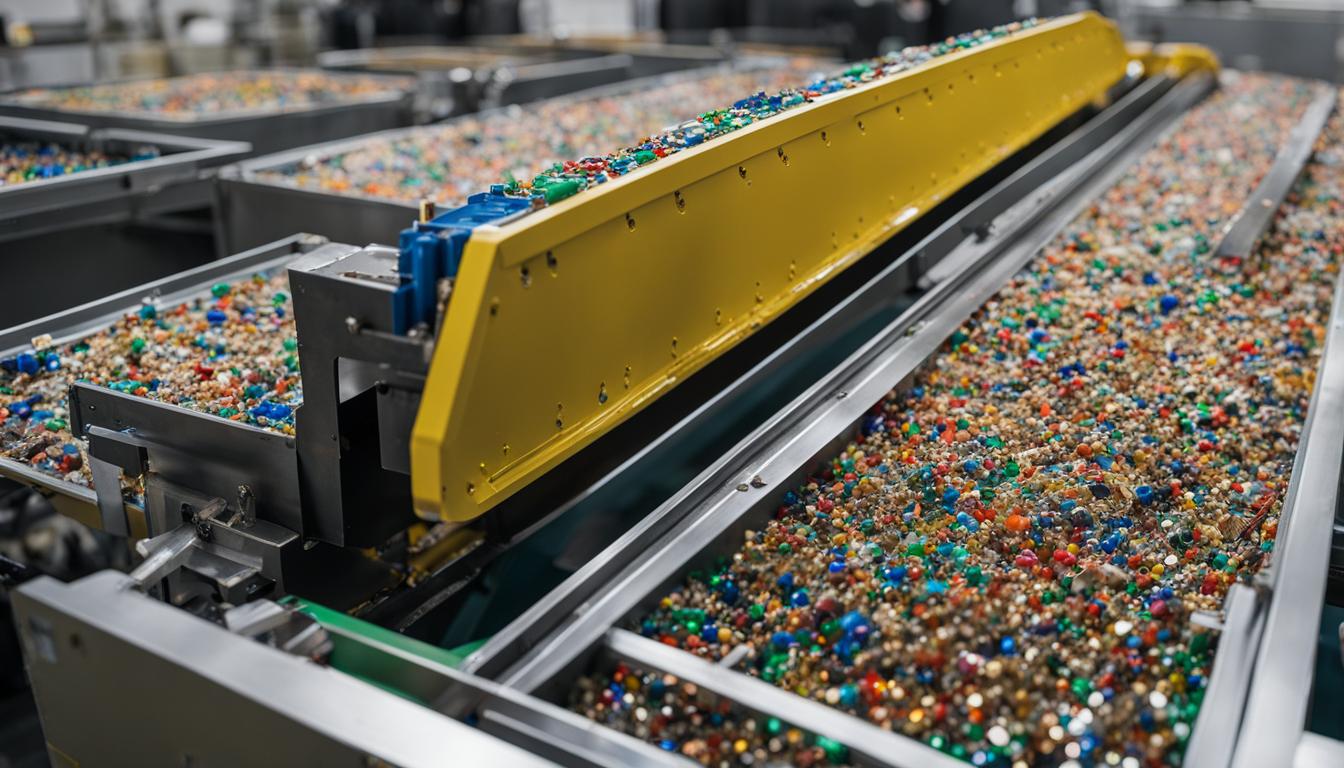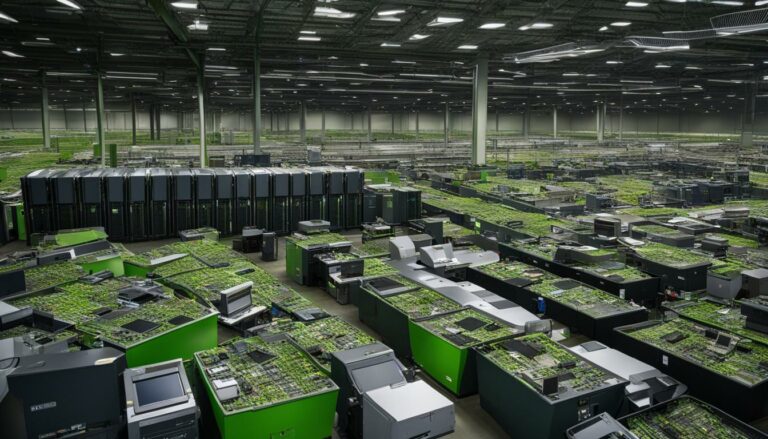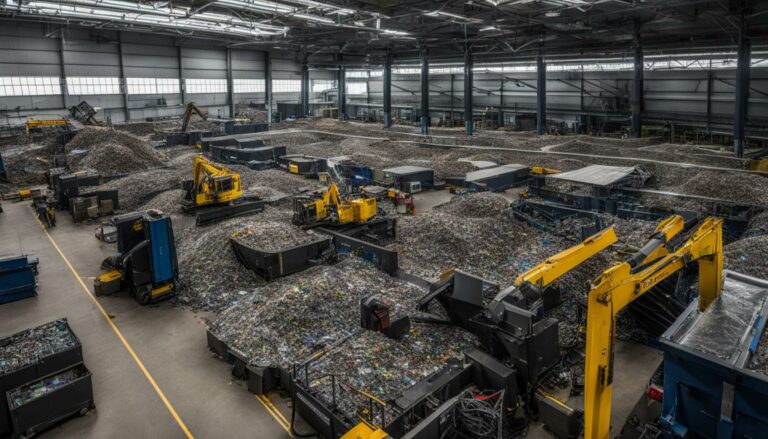Environmental Activism and IT Recycling
In today’s world, environmental activism and IT recycling go hand in hand. It is crucial to adopt sustainable practices when disposing of electronic waste to minimize its impact on the environment. Proper management of e-waste, also known as electronic waste, contributes to a sustainable future. Recycling IT equipment in an eco-friendly manner reduces the carbon footprint and promotes responsible consumption.
Key Takeaways
- Sustainable IT recycling plays a vital role in environmental activism.
- Proper electronic waste management contributes to a sustainable future.
- Recycling IT equipment reduces the carbon footprint and promotes responsible consumption.
- Eco-friendly IT disposal is essential for minimizing the impact on the environment.
- Adopting sustainable practices in IT recycling helps create a greener and more environmentally-conscious society.
The Importance of Upcycled and Recycled Art in Environmental Activism
Upcycled and recycled art plays a significant role in environmental activism. It involves transforming waste materials into new products with artistic or environmental value, extending the life of materials that are difficult or impossible to recycle. Recycled art not only creates beautiful pieces but also highlights the problem of waste materials damaging the environment, such as plastic. Art has the power to inspire action and bring about change.
In the realm of environmental activism, upcycled and recycled art holds immense artistic value. It showcases the creativity and ingenuity of artists who are dedicated to promoting sustainability and reducing waste. By repurposing discarded materials, these artists give these materials an extended life and demonstrate that beauty can be found in the most unlikely places. Upcycled and recycled art challenges the perception of waste, encouraging viewers to reconsider their own consumption habits and make more environmentally conscious choices.
“Recycled art is a powerful tool for environmental activism. It allows us to give new life to waste materials while raising awareness about the environmental issues we face. Through the creation of these art pieces, we can inspire individuals and communities to take action towards a greener future.” – Environmental Artist
Furthermore, upcycled and recycled art serves as a tangible reminder of the urgent need for sustainable practices. It reminds us of the impact of our throwaway culture and encourages us to rethink our relationship with waste. By using waste materials as a medium, artists can communicate the message of environmental activism in a visually striking and thought-provoking way. Through their art, they ignite conversations and inspire individuals to become agents of change, fostering a deeper understanding of the importance of waste reduction and recycling.
Table: Comparison of Upcycled and Recycled Art
| Upcycled Art | Recycled Art |
|---|---|
| Transforms waste materials into new products | Repurposes waste materials |
| Focuses on artistic value and aesthetic appeal | Highlights environmental issues and waste reduction |
| Often uses unconventional materials | Utilizes materials that are difficult to recycle |
| Promotes creativity and innovation | Raises awareness and inspires action |
The importance of upcycled and recycled art in environmental activism cannot be overstated. It serves as a powerful visual representation of the need for sustainable practices and waste reduction. Through their creativity and innovation, artists amplify the message of environmental activism, inspiring individuals to take action and make a positive impact on the planet.
Brian Mock: Inspiring Environmental Activism Through Upcycled Art
Renowned sculptor Brian Mock is a shining example of how art can inspire environmental activism. Using his exceptional artistic skill, he creates captivating sculptures out of 100% reclaimed materials. By repurposing discarded nuts, bolts, screws, and cutlery, Brian gives these items a second life and raises awareness about the importance of upcycling.
Through his upcycled sculptures, Brian Mock sparks environmental awareness and encourages viewers to appreciate the beauty and significance of reusing materials. His intricate and unique pieces serve as a powerful reminder that discarded items can be transformed into stunning works of art. By showcasing the artistic potential of reclaimed materials, Brian inspires individuals to consider their own consumption habits and embrace sustainable practices.
“Brian Mock’s sculptures serve as a powerful reminder of the immense artistic and environmental value that can be found in discarded items. His work beautifully combines artistic skill with a deep commitment to raising awareness about the importance of upcycling and environmental conservation.”
The Second Life of Discarded Items
One of the key messages conveyed through Brian’s art is the concept of giving discarded items a second life. By transforming everyday metal objects into intricate sculptures, he challenges the notion of waste and inspires viewers to reconsider their own attitudes towards consumption. Through his creations, Brian demonstrates that even the most seemingly insignificant items can be repurposed and valued.
Brian Mock’s upcycled sculptures not only showcase his artistic talent but also serve as a catalyst for environmental change. By highlighting the potential beauty and value in discarded items, he encourages individuals to adopt a more sustainable mindset and become active participants in the global movement towards responsible consumption and waste reduction.
| Sculpture Name | Materials Used | Artistic Inspiration |
|---|---|---|
| Serenity | Reclaimed bolts, screws, and cutlery | Nature and the importance of preserving our environment |
| Unbound | Recycled bicycle chains and gears | Freedom and breaking free from the constraints of waste |
| Metamorphosis | Reclaimed nuts, bolts, and scrap metal | The transformative power of upcycling and sustainability |
Through his remarkable upcycled sculptures, Brian Mock inspires us to view discarded items in a new light. By recognizing the artistic potential and environmental significance of reclaimed materials, he encourages us all to make a difference in our daily lives and contribute to a more sustainable future.

Caroline Berzi’s Upcycled Art as a Tool for Environmental Education
Caroline Berzi, an Egyptian artist, is making a powerful impact on environmental education through her upcycled artworks. With a focus on waste plastic bottles, Berzi raises awareness about the global problem of unregulated plastic production and its detrimental effects on marine life. By transforming discarded plastic bottles into captivating art pieces, she sheds light on the urgent need for sustainable solutions to protect our oceans and wildlife.
Berzi’s art is inspired by the rich heritage of Ancient Egypt, incorporating symbolism that represents the fragile beauty of nature. Her upcycled art serves as a visual reminder of the interconnectedness between human actions and the environment. Through her creative expression, Berzi encourages viewers to reflect on their own consumption habits and the impact they have on the natural world.
“By creating art from waste, I hope to inspire others to see the potential in materials that are often overlooked and discarded,” says Berzi.
Caroline Berzi’s upcycled artworks not only captivate viewers with their beauty but also serve as a catalyst for dialogue and action surrounding environmental conservation. Her art represents a call to reconsider our relationship with plastic and embrace more sustainable practices for the sake of our planet’s future.
| Impact of Caroline Berzi’s Upcycled Art | Key Points |
|---|---|
| Heightened Awareness | Through her upcycled art, Berzi raises awareness about the environmental impact of plastic waste. |
| Marine Life Conservation | Her focus on waste plastic bottles highlights the need to protect marine life from the harmful effects of plastic pollution. |
| Ancient Egyptian Heritage | Berzi’s art incorporates symbolism inspired by Ancient Egyptian heritage, emphasizing the timeless connection between humanity and nature. |
| Inspiration for Change | By transforming discarded materials into art, Berzi inspires individuals to see the potential in waste and make conscious choices to reduce their environmental footprint. |
SEATY’s Urban Art and the Message of Recycling
SEATY, a contemporary artist, harnesses the power of urban art to promote recycling and give discarded objects a second life. Inspired by the challenges of the Covid-19 lockdown, SEATY turned to reclaimed signs, wood, and cardboard as unconventional canvases for artistic expression. By embracing recycled materials, SEATY not only challenges the perception of waste but also encourages viewers to rethink their consumption habits and consider the potential of overlooked materials.
SEATY’s art serves as a lockdown-inspired artistic challenge, demonstrating that even in difficult times, creativity can flourish. Through his unique urban art pieces, SEATY aims to promote sustainability and inspire others to join the recycling movement. By repurposing discarded objects, he communicates a powerful message that recycling can transform waste into something beautiful, reinforcing the importance of promoting a more environmentally conscious society.
SEATY’s urban art captures the essence of recycling and second life. His work challenges traditional notions of artistry and prompts viewers to reimagine the potential of discarded materials. Through his creative and thought-provoking pieces, SEATY encourages us to see beauty and artistic value in what others perceive as trash.
SEATY’s artistic creations are not only visually captivating but also serve as a catalyst for change. By engaging with his vibrant urban art, individuals are encouraged to question their own consumption habits and become more actively involved in recycling efforts. SEATY’s work sparks conversation and prompts viewers to consider their impact on the environment, reinforcing the idea that small actions contribute to a larger collective effort towards a more sustainable future.
SEATY’s Urban Art and Recycling: A Visual Showcase
| Artwork | Description |
|---|---|
| The Reclaimed Rooster | A vibrant installation made from reclaimed signs, symbolizing environmental resilience and the potential for transformation. |
| Cardboard Cityscape | A detailed cityscape created entirely from cardboard, highlighting the overlooked potential of everyday materials. |
| Wooden Wonders | A collection of intricately carved wooden sculptures made from reclaimed wood, showcasing the beauty of nature and the importance of sustainable practices. |
SEATY’s urban art stands as a testament to the transformative power of recycling. Through his creative vision and innovative use of materials, SEATY inspires individuals to recognize the value of recycling and the potential for artistic expression in discarded objects. By promoting recycling and second life, SEATY’s art challenges conventional notions of waste and encourages society to adopt more sustainable practices.
Nancy Judd’s Fashion Art for Environmental Conservation
Nancy Judd, a visual artist and advocate for environmental conservation, uses her project, Recycle Runway, to create stunning fashion pieces with a sustainable twist. Judd’s work draws attention to pressing issues such as mass landfills, contaminated oceans, and destroyed ecosystems, all through the medium of fashion. By repurposing litter and trash, Judd’s designs serve as a powerful reminder of the environmental impact of our consumer habits.
Recycle Runway aligns with the United Nations Sustainable Development Goals, particularly Climate Action and Responsible Consumption. The fashion art created by Judd not only showcases exquisite craftsmanship, but also carries an underlying message of environmental awareness and responsibility. Each piece has an environmental function, challenging viewers to reconsider their own impact on the planet and inspiring them to adopt more sustainable practices.
“I hope to inspire people to think differently about their trash and their role in the world,” says Judd. “Fashion is a universal language that can engage people from all walks of life in the conversation about environmental stewardship.”
Judd’s fashion art serves as a thought-provoking medium for education and change. Through her innovative approach to sustainable fashion, she encourages viewers to reconsider their consumption patterns and embrace a more environmentally-conscious lifestyle.
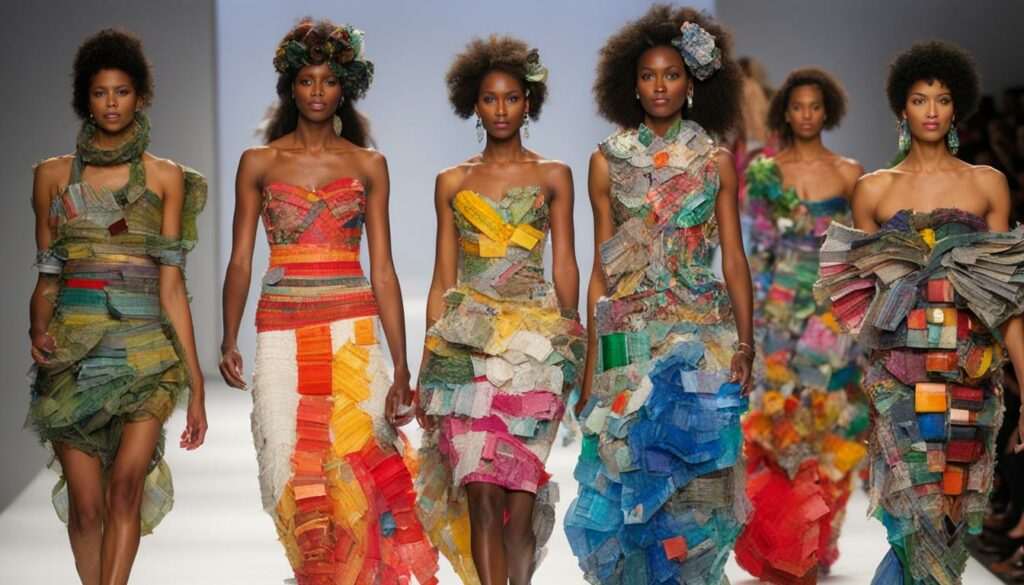
The Impact of Recycle Runway
The Recycle Runway project not only creates stunning fashion art but also sparks conversations and raises awareness about environmental conservation. Judd’s sustainable fashion designs have been showcased in prestigious venues such as museums, galleries, and even fashion weeks around the world. Her work demonstrates that fashion can be both beautiful and sustainable, challenging the perception that style and environmental consciousness are mutually exclusive.
| Key Points | Impact |
|---|---|
| Highlighting mass landfills and plastic waste | Raises awareness about the global issue of waste accumulation and encourages recycling efforts |
| Representing destroyed ecosystems and polluted oceans | Sheds light on the devastating effects of human activities on the environment, urging individuals and industries to reduce their ecological footprint |
| Promoting responsible consumption | Inspires viewers to reevaluate their purchasing choices and opt for sustainable alternatives |
Nancy Judd’s fashion art through Recycle Runway serves as a powerful catalyst for change. By combining artistic creativity with environmental consciousness, Judd encourages individuals to embrace sustainable fashion choices and contribute to the preservation of our planet.
The Power of Personal and Collective Action in Climate Change
Addressing climate change requires both personal and collective action. While individual actions like changing lightbulbs or reducing plastic usage can contribute to the cause, it is essential to recognize the broader systemic issues and hold corporations accountable for their environmental impact. Climate strikes, rallies, and civic engagement play a crucial role in pressuring governments and industries to prioritize sustainable practices. By combining personal actions with collective movements, we can drive the systemic changes needed to combat climate change effectively.
Individual action is an important first step towards mitigating climate change. By making simple changes in our daily lives, such as reducing energy consumption, opting for sustainable transportation, and practicing mindful consumption, we can significantly reduce our carbon footprint. These individual actions not only demonstrate personal responsibility but also raise awareness among our peers and communities. Individually, we can inspire others to follow suit and collectively make a significant impact.
“Never doubt that a small group of thoughtful, committed citizens can change the world; indeed, it’s the only thing that ever has.” – Margaret Mead
However, personal actions alone are not enough to address the magnitude of the climate crisis. It is crucial to recognize the power of collective responsibility and systemic change. Holding corporations accountable for their emissions, waste management, and unsustainable practices is necessary to drive meaningful change. By supporting organizations that prioritize sustainability and advocating for stricter regulations and policies, we can encourage companies to adopt more environmentally-friendly practices.
The Role of Climate Strikes
Climate strikes are powerful demonstrations of collective action that demand urgent climate solutions. Led by passionate activists, these strikes bring attention to the pressing issue of climate change and demand policy changes from governments and corporations. Large-scale protests not only raise public awareness but also exert pressure on decision-makers to prioritize sustainability and implement climate-friendly policies. By participating in climate strikes and supporting grassroots movements, individuals can contribute to the global fight against climate change.
| Climate Change Solutions | Example |
|---|---|
| Transitioning to renewable energy sources | Investing in solar and wind energy projects |
| Implementing sustainable transportation options | Expanding public transit systems and promoting cycling |
| Reducing greenhouse gas emissions | Setting and achieving ambitious emission reduction targets |
| Restoring and protecting ecosystems | Conservation efforts and reforestation projects |
| Adopting circular economy practices | Promoting recycling and reducing waste generation |
In conclusion, combating climate change requires a combination of personal actions and collective responsibility. While individuals can make a difference through their choices and behaviors, it is essential to tackle the systemic issues and hold corporations accountable for their environmental impact. By participating in climate strikes, advocating for change, and supporting sustainable initiatives, we can drive the systemic changes needed to create a greener and more sustainable future for all.
Conclusion
Environmental activism and IT recycling are pivotal in shaping a sustainable future. Through the power of upcycled and recycled art, urban art, and fashion-focused environmental art, artists inspire individuals and communities to reevaluate their consumption habits and take action towards a greener and more sustainable world.
While personal actions matter, it is collective responsibility and systemic changes that will truly address the challenges of climate change. It is imperative to hold corporations accountable for their environmental impact and advocate for sustainable practices on a larger scale. By doing so, we can contribute to the creation of a more environmentally-conscious society.
Let us join the charge for environmental activism in IT recycling and work together towards a greener and more sustainable future. By embracing collective responsibility and driving systemic change, we can make a significant difference in preserving our planet for future generations.
FAQ
What is the importance of environmental activism in IT recycling?
Environmental activism in IT recycling is crucial because it helps minimize the impact of electronic waste on the environment. It promotes responsible consumption and reduces the carbon footprint through sustainable practices.
How does upcycled and recycled art contribute to environmental activism?
Upcycled and recycled art plays a significant role in environmental activism by transforming waste materials into new products with artistic or environmental value. It extends the life of difficult-to-recycle materials and highlights the problem of waste damaging the environment, inspiring action and change.
Who is Brian Mock and how does his art promote environmental awareness?
Brian Mock is a sculptor who creates exceptional upcycled sculptures using 100% reclaimed materials. His intricate and unique pieces give a second life to discarded everyday metal items, raising environmental awareness and inspiring appreciation for the beauty and importance of upcycling.
How does Caroline Berzi use upcycled art to promote environmental education?
Caroline Berzi uses upcycled artworks, particularly those made from waste plastic bottles, to highlight the global issue of unregulated plastic production and its impact on marine life. Her art incorporates symbols representing nature’s fragility and beauty, raising awareness and inspiring behavior changes to address environmental issues.
What is SEATY’s approach to promoting recycling through urban art?
SEATY, a contemporary artist, promotes recycling and gives discarded objects a second life through urban art. During the Covid-19 lockdown, SEATY started creating art on reclaimed signs, wood, and cardboard, challenging the perception of waste and encouraging viewers to rethink their consumption habits.
How does Nancy Judd advocate for environmental conservation through fashion and art?
Nancy Judd’s project, Recycle Runway, creates sustainable fashion pieces addressing issues like mass landfills, contaminated oceans, and destroyed ecosystems. Her fashion art uses litter and trash to create beautiful and thought-provoking designs, inspiring viewers to reconsider their impact on the environment.
What is the role of personal and collective action in addressing climate change?
Personal actions like changing lightbulbs or reducing plastic usage contribute to the cause of climate change. However, collective action, such as climate strikes and civic engagement, is crucial in pressuring governments and industries to prioritize sustainable practices. Both personal and collective actions are needed to drive systemic changes effectively.
What is the significance of environmental activism and IT recycling for a sustainable future?
Environmental activism and sustainable IT recycling are integral to creating a sustainable future. By embracing responsible practices and holding corporations accountable, we can contribute to a more environmentally-conscious society and work towards a greener and more sustainable future.
Source Links
- https://www.artshelp.com/environmental-activist-and-recycling-queen-nancy-judd-uses-junk-to-create-one-of-a-kind-stunning-fashions/
- https://www.vox.com/the-highlight/2019/5/28/18629833/climate-change-2019-green-new-deal
- https://www.watsonwolfe.com/2021/01/04/recycled-art-a-form-of-environmental-activism/

